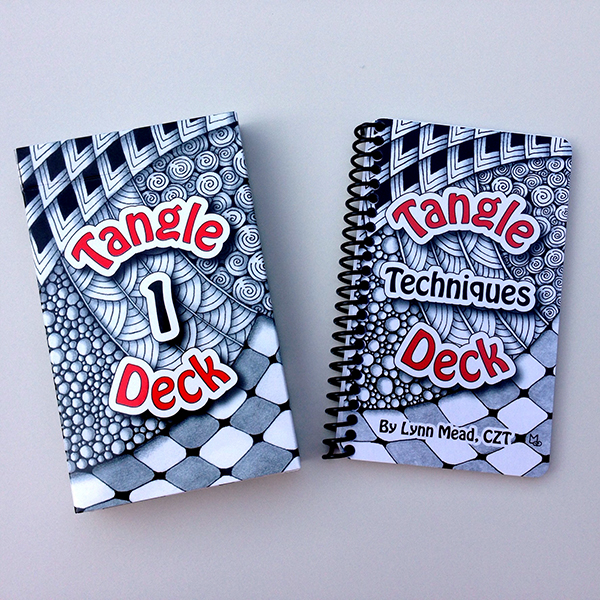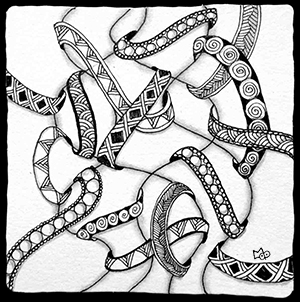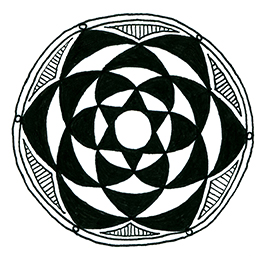
Tangle Deck now available in the U.S.
International Sales available in the near future
OK, I admit it took a little longer than planned, but I’m happy to announce that Tangle Deck is now on sale through my web site, www.atanglersmind.com.
A Little History
Tangle Deck had its start over two years ago before I even became a CZT. Since then it has gone through several revisions based on feedback from Tanglers, CZTs and even Rick at Zentangle headquarters. The cards started out as 2.5” x 3.5” poker size cards but the step-outs seemed too small. I ended up increasing the size of the cards to 3.5” x 5.75” so they would be easier to use by everyone. I also felt the tangles should be categorized in some way and went through several schemes for doing so. I finally decided the best way to categorize tangles was by showing the elemental strokes of the Zentangle Method used to draw them. I also changed the tangles that were included to ensure they were all “officially released” by Zentangle HQ. I had originally not intended to include a book, but as I progressed in my Zentangle practice it became increasingly clear to me that one was needed, so I created Tangle Deck Techniques. I also wanted to provide examples of the techniques and demonstrate that it’s not how many tangles you know but what you can do with them that matters. That is how the drawings for the card backs came about. The end result of all this research and development is the current Tangle Deck now available on my site.
The official marketing blurb…
Tangle Deck was created by Certified Zentangle® Teacher, Lynn Mead, to provide a durable and portable reference to copyright-free tangles introduced by Zentangle Inc. These tangles are designed to be easy to learn and use with the Zentangle Method of drawing. Tangle Deck is a resource that includes step by step instructions, provides ideas and inspiration, and is as portable as the rest of your Zentangle supplies. Its purpose is to inspire you, stimulate creativity, and nurture you on your Zentangle journey.
- 52 copyright-free and easy to learn Tangles introduced by Zentangle Inc.
- Large 3.5″ x 5.75″ cards are designed to be used by all ages.
- Coated cards are durable and let you easily sort through the deck.
- One side has tangle step-outs and tips and the other side is a monotangle drawing that uses tanglenhancers and tangleations.
- Each card shows the elemental strokes needed to create the tangle.
- Individual cards let you select several tangles and display them right in front of you. No flipping back and forth between pages.
- The accompanying book, Tangle Deck Techniques, provides suggestions for exploring tangles using tanglenhancers and tangleations.
Here’s what CZTs are saying…
“I love the deck! Your hard work and effort really shines through with this product! The deck itself is beautiful with clear instructions, wonderful size to see, and the pictures on the back with all the tangelation possibilities are incredible. Your art work is really beautiful too. I also love the techniques book that you included….wonderful details! I think you hit it out of the park with this one.”
Susan Clark, CZT
Nancy Smith, CZT
“The Tangle Deck arrived today. What a WONDERFUL job you have done. Love, love it. The booklet is excellent. You both explain and illustrate in clear, concise terms and renditions. I LOVE your artwork on the cards – and how you represented tangleations instead of just putting the tangle on there. The Enhancers section is terrific – especially that dew drop! You give credit to R&M and have represented Zentangle perfectly. I just love the side bar with the strokes you use. So helpful – and a different touch from other publications, etc. The quality of the coated card is exceptional – I’m glad you did the book using that, as well. Very professional. Kudos and congratulations! Bravo, bravo!!!!”
Jenny Perruzzi, CZT
If you are interested in purchasing Tangle Deck, Click Here
Questions? contact sales@atanglersmind.com
Tangle Deck was developed by Meadowmead Studios LLC and is not an official Zentangle product.






























































